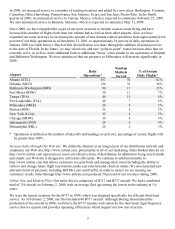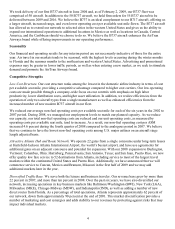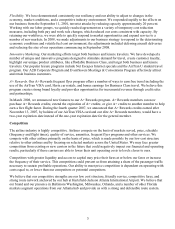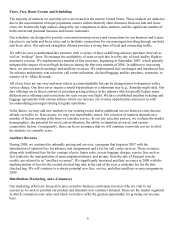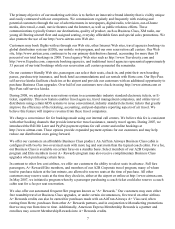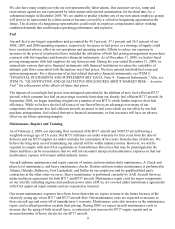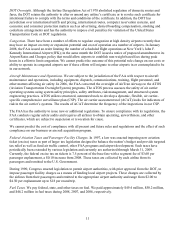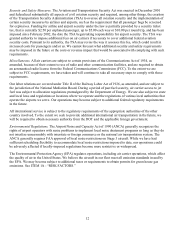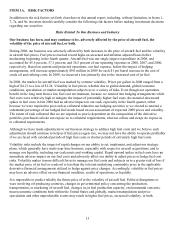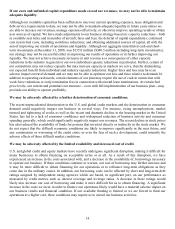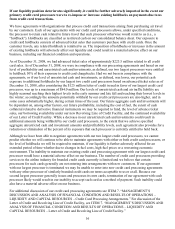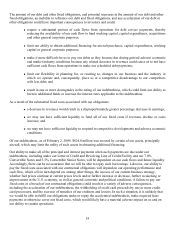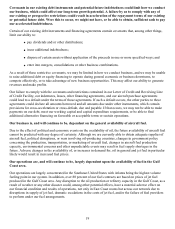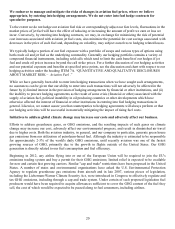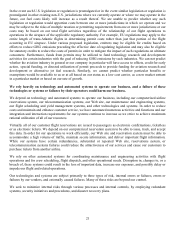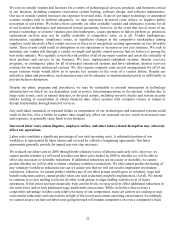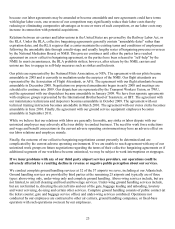Airtran 2008 Annual Report Download - page 21
Download and view the complete annual report
Please find page 21 of the 2008 Airtran annual report below. You can navigate through the pages in the report by either clicking on the pages listed below, or by using the keyword search tool below to find specific information within the annual report.ITEM 1A. RISK FACTORS
In addition to the risk factors set forth elsewhere in this annual report, including, without limitation, in Items 1,
7, 7a, and 9a, investors should carefully consider the following risk factors before making investment decisions
regarding our securities.
Risks Related To Our Business and Industry
Our business has been, and may continue to be, adversely affected by the price of aircraft fuel, the
volatility of the price of aircraft fuel, or both.
During 2008, our business was adversely affected by both increases in the price of aircraft fuel and the volatility
in aircraft fuel prices. Fuel prices reached record highs on an actual and inflation adjusted basis before
moderating beginning in the fourth quarter. Aircraft fuel was our single largest expenditure in 2008, and
accounted for 45.5 percent, 37.1 percent, and 36.5 percent of our operating expenses in 2008, 2007, and 2006,
respectively. Based on current and projected operations, our fuel expense, before the impact of hedging
arrangements, will increase approximately $9.0 million in 2009 for each $1 per barrel increase in the cost of
crude oil and refining costs. In 2008, we incurred a loss primarily due to the increased cost of jet fuel.
In 2008, the market for aircraft fuel was marked by extreme volatility. Prices per gallon in 2008 ranged from a
high of $4.21 to a low of $1.24. Volatility in fuel prices, whether due to global demand, global economic
conditions, speculation, or market manipulation subjects us to a variety of risks. Even though our operations
benefit in the long term from a low fuel cost environment, because we entered into hedging arrangements while
fuel costs were relatively high to mitigate the impact of potentially higher fuel costs, the material downward
spikes in fuel costs in late 2008 had an adverse impact on our cash, especially in the fourth quarter, either
because we were required to post cash as collateral related to our hedging activities or we elected to unwind a
substantial percentage of our hedged fuel needs based on our assessment of expected 2009 prices and volatility.
The extent of cash collateral that we are required to post is dependent on the composition of the derivative
portfolio; purchased calls do not expose us to collateral requirements, whereas collars and swaps do expose us
to collateral requirements.
Although we have made adjustments to our business strategy to address high fuel costs and we believe such
adjustments should continue to help us if fuel prices again rise, we may not have the ability to operate profitably
if we are faced with extended periods of high fuel costs or shorter periods of extremely high fuel costs.
Volatility risks include the impact of rapid changes on our ability to set, implement, and adjust our strategic
plans, which generally have multi-year time horizons, especially with respect to aircraft acquisitions, and to
manage our liquidity, including our cash assets and working capital. Rapid upward spikes in fuel costs have an
immediate adverse impact on our fuel costs and adversely affect our ability to adjust prices or hedge fuel cost
risks. Volatility makes it more difficult for us to manage our fuel costs and subjects us to a greater risk of loss if
the market price of jet fuel or crude oil is less than the relevant underlying commodity price in the applicable
derivative financial arrangements utilized to hedge against price changes. Accordingly, volatility in fuel prices
may have an adverse effect on our financial condition, results of operations, or liquidity.
It is impossible to predict reliably the future price of or the volatility of aircraft fuel. Political disruptions or
wars involving oil-producing countries, changes in governmental policy concerning the production,
transportation, or marketing of aircraft fuel, changes in jet fuel production capacity, environmental concerns,
macroeconomic conditions both within the United States and globally, market manipulation and price
speculation and other unpredictable events may result in higher fuel prices, increased volatility, or both.
13


